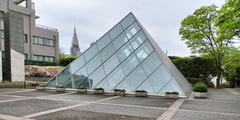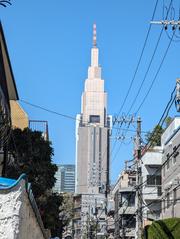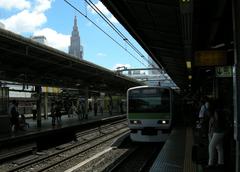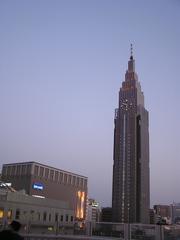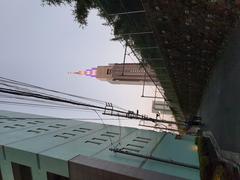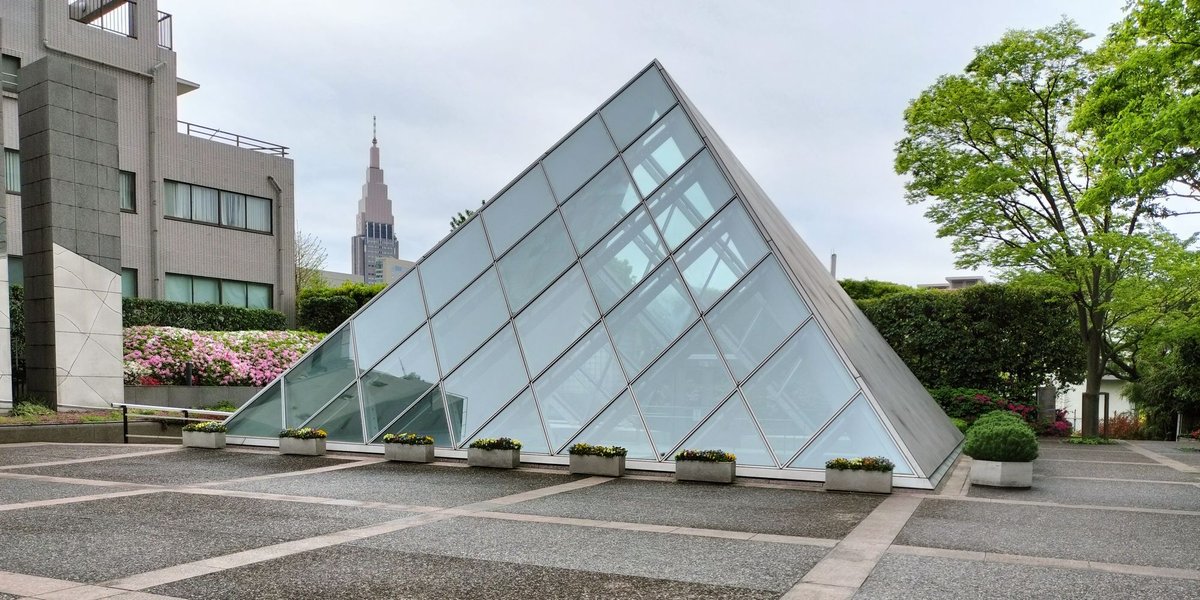
NTT Docomo Yoyogi Building: Visiting Hours, Tickets, and Tourist Guide to a Tokyo Landmark
Date: 14/06/2025
Introduction
The NTT Docomo Yoyogi Building is a defining feature of Tokyo’s skyline, rising above the vibrant Shinjuku and Yoyogi districts. Completed in 2000, this skyscraper marries architectural grandeur with technological innovation, symbolizing both Tokyo’s rapid modernization and its enduring commitment to progress. Known for its Art Deco-inspired silhouette and the enormous illuminated clock added in 2002, the building is instantly recognizable and serves as a beacon for locals and visitors alike.
While the main tower is not open to the public, its striking presence, proximity to major transport hubs, and integration with Tokyo’s rich urban fabric make it a must-see for architecture enthusiasts, travelers, and photographers. This comprehensive guide provides detailed insights into the NTT Docomo Yoyogi Building’s history, architectural significance, viewing tips, accessibility, nearby attractions, and essential travel advice. For further reading and visual references, see sources such as Michael John Grist, Wikipedia, and Muza-chan.
Table of Contents
- Overview and Historical Background
- Architectural Design and Symbolism
- Technological and Structural Features
- Visiting Information: Hours, Tickets, and Access
- Best Viewing Spots and Photo Tips
- Accessibility and Amenities
- Notable Events and Community Impact
- Nearby Attractions and Suggested Itineraries
- Frequently Asked Questions (FAQ)
- Visual Media and Suggested Alt Tags
- Related Articles and Official Links
- Summary and Final Recommendations
- Sources
Overview and Historical Background
Commissioned by NTT Docomo, a subsidiary of Nippon Telegraph and Telephone Corporation (NTT), the NTT Docomo Yoyogi Building was constructed between 1997 and 2000 to serve as both a corporate headquarters and a telecommunications hub. Its completion marked a shift in Tokyo’s architectural trends, with an emphasis on landmark design and advanced infrastructure over utilitarian office blocks (Michael John Grist; Wikipedia).
The tower’s 15-meter diameter clock, added in November 2002, commemorated NTT Docomo’s 10th anniversary. It quickly became an iconic feature, visible from various vantage points and serving as a practical reference for millions of Tokyoites (Muza-chan).
Architectural Design and Symbolism
Design Inspiration and Structure
The building’s design, by Kajima Design of Kajima Corporation, draws clear inspiration from global icons like New York’s Empire State Building. Its stepped, symmetrical facade, vertical lines, and spire evoke Art Deco grandeur while adapting to the modern Tokyo cityscape (Art Facts). Standing at 240 meters to the roof (272 meters including the spire), it is among Tokyo’s tallest and most prominent buildings (Skyscraper Center).
Constructed with an all-steel frame, the building offers seismic resilience—a vital feature in earthquake-prone Japan. It comprises 33 stories above ground and three below, with a total floor area exceeding 51,000 square meters (Skyscraper Center).
The Iconic Clock and Illumination
The monumental clock face, illuminated with LED technology, is positioned 150 meters above ground and measures 15 meters in diameter. Not only does it serve as a timepiece and a weather indicator (with color-changing lighting), but it also stands out as a nightly beacon on the Tokyo skyline (Architecture Courses; Muza-chan).
Symbolism and Urban Impact
The NTT Docomo Yoyogi Building is more than office space; it is a symbol of Japan’s ambitions during the economic boom and a visual anchor for the Shinjuku and Yoyogi districts. Its prominence has made it a frequent backdrop in media and a reference point for navigation and city orientation (Ten Minute Tokyo).
Technological and Structural Features
As the headquarters for NTT Docomo, the building is equipped with extensive technical infrastructure, including advanced server farms and communications equipment. These facilities are critical for the company’s role as Japan’s leading mobile operator and ensure robust digital connectivity across Tokyo (Muza-chan).
The building’s structural engineering prioritizes earthquake resistance, with flexible steel frameworks and reinforced cores, exemplifying Tokyo’s approach to safe, high-rise construction (Skyscraper Center).
Visiting Information: Hours, Tickets, and Access
Visiting Hours and Ticketing
The main tower is not open to the public. There are no observation decks, guided tours, or ticketed entry for visitors. All access to the interior is strictly limited to authorized personnel (Wikipedia).
Annex Facilities
The annex building adjacent to the tower houses restaurants and cafes. These are open to the public during typical dining hours, generally from late morning to late evening. Check individual establishment websites or Go Tokyo for up-to-date information.
How to Get There
- Yoyogi Station (JR Yamanote Line, Chūō-Sōbu Line, Toei Oedo Line) is a 5-minute walk.
- Shinjuku Station is a 10-minute walk, offering connections across Tokyo (Go Tokyo).
Public transportation is recommended as the most efficient way to access the area.
Best Viewing Spots and Photo Tips
Although you cannot enter the main tower, the following locations offer impressive views and great photo opportunities:
- Yoyogi Park: Open spaces and peaceful ambiance ideal for capturing the building’s full height.
- Shinjuku Southern Terrace: Elevated viewpoints perfect for sunset and night shots.
- Shinjuku Gyoen National Garden: Especially picturesque during cherry blossom season.
- Meiji Jingu Gaien: Panoramic perspectives amid seasonal foliage.
For nighttime photography, visit during special illuminations or holidays when the clock is especially vibrant.
Accessibility and Amenities
The area surrounding the NTT Docomo Yoyogi Building is highly accessible:
- Wheelchair users: Nearby parks and streets offer smooth pavements, ramps, and accessible restrooms.
- Annex restaurants: Generally accessible, but check in advance for specific needs.
- Transit: Nearby stations are equipped with elevators and escalators.
Amenities such as restrooms, convenience stores, and vending machines are available in the area. Most accept IC cards, but carrying some cash is advisable (Travels with Elle).
Notable Events and Community Impact
- 1997: Construction begins.
- 2000: Building completion.
- 2002: Clock installation to celebrate NTT Docomo’s 10th anniversary.
- Ongoing: The building features special lighting for holidays and citywide events.
Though not open to the public, the building’s illuminated clock and presence make it a focal point for seasonal photography, media, and community gatherings, especially during cherry blossom season in Shinjuku Gyoen (UME Travel).
Nearby Attractions and Suggested Itineraries
Enhance your visit by exploring these local highlights:
- Yoyogi Park: Leisure, jogging, festivals.
- Meiji Shrine: Historic Shinto site amid forested grounds.
- Shinjuku Gyoen National Garden: Renowned for seasonal flowers.
- Harajuku/Takeshita Street: Youth culture, shopping, and food.
It’s easy to combine a stop at the NTT Docomo Yoyogi Building with a broader exploration of Tokyo’s dynamic cityscape.
Frequently Asked Questions (FAQ)
Q: Can I tour the NTT Docomo Yoyogi Building?
A: No, the main tower is not open for tours or public visits.
Q: Are there tickets or an admission fee?
A: No, viewing the exterior and visiting the annex restaurants are free; no tickets are required.
Q: What are the best photo spots?
A: Yoyogi Park, Shinjuku Southern Terrace, and Shinjuku Gyoen National Garden.
Q: Is the area wheelchair accessible?
A: Yes, public spaces and annex facilities are accessible.
Q: Are there guided tours?
A: No official tours of the tower, but walking tours of the Shinjuku and Yoyogi areas are available through local agencies.
Q: When is the best time to visit?
A: Late afternoon and early evening, especially during cherry blossom season or special illuminations.
Visual Media and Suggested Alt Tags
- Daytime and nighttime images of the NTT Docomo Yoyogi Building exterior.
- Close-ups of the illuminated clock face.
- Photos from Yoyogi Park and Shinjuku Southern Terrace.
- Annex dining areas.
- Map of the area.
Suggested alt tags: “NTT Docomo Yoyogi Building Tokyo,” “NTT Docomo Yoyogi Building clock at night,” “View of NTT Docomo Yoyogi Building from Yoyogi Park.”
Related Articles and Official Links
- NTT Docomo Official Website
- Go Tokyo Official Tourism Page
- Muza-chan’s Gate to Japan
- Travels with Elle: Tokyo Travel Tips
- Ten Minute Tokyo: Yoyogi Superguide
- Pineqone Attraction Guide
- UME Travel: Shinjuku Gyoen Sakura
- e-housing.jp: Tokyo Architecture
- Skyscraper Center
- Art Facts: Famous Buildings in Tokyo
- Architecture Courses: Tallest Clock Towers
Summary and Final Recommendations
The NTT Docomo Yoyogi Building stands as a testament to Tokyo’s spirit of innovation and urban sophistication. While public entry is limited, the building’s illuminated clock, bold architecture, and strategic location make it a must-see landmark for any visitor. Enjoy its views from nearby parks, explore the vibrant neighborhoods of Shinjuku, Harajuku, and Yoyogi, and immerse yourself in the dynamic blend of tradition and modernity that defines Tokyo.
For the latest visitor information, dining updates, and special event schedules, consult official tourism resources like Go Tokyo. To enhance your Tokyo adventure, download the Audiala app for curated guides, maps, and insider tips.
Sources
- Michael John Grist
- Wikipedia
- Muza-chan
- Pineqone
- e-housing.jp
- Go Tokyo
- Travels with Elle
- Skyscraper Center
- Art Facts
- Architecture Courses
- Ten Minute Tokyo
- UME Travel
